Zechen Bai
Impossible Videos
Mar 18, 2025Abstract:Synthetic videos nowadays is widely used to complement data scarcity and diversity of real-world videos. Current synthetic datasets primarily replicate real-world scenarios, leaving impossible, counterfactual and anti-reality video concepts underexplored. This work aims to answer two questions: 1) Can today's video generation models effectively follow prompts to create impossible video content? 2) Are today's video understanding models good enough for understanding impossible videos? To this end, we introduce IPV-Bench, a novel benchmark designed to evaluate and foster progress in video understanding and generation. IPV-Bench is underpinned by a comprehensive taxonomy, encompassing 4 domains, 14 categories. It features diverse scenes that defy physical, biological, geographical, or social laws. Based on the taxonomy, a prompt suite is constructed to evaluate video generation models, challenging their prompt following and creativity capabilities. In addition, a video benchmark is curated to assess Video-LLMs on their ability of understanding impossible videos, which particularly requires reasoning on temporal dynamics and world knowledge. Comprehensive evaluations reveal limitations and insights for future directions of video models, paving the way for next-generation video models.
ShowUI: One Vision-Language-Action Model for GUI Visual Agent
Nov 26, 2024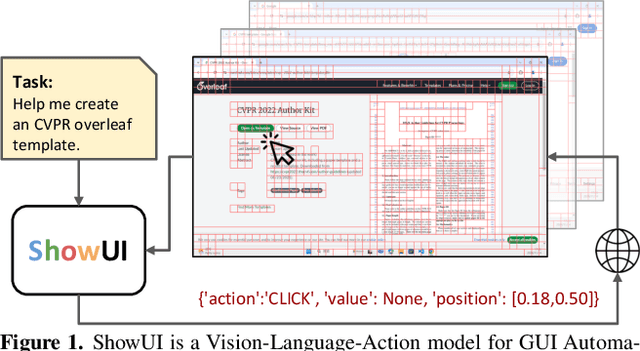
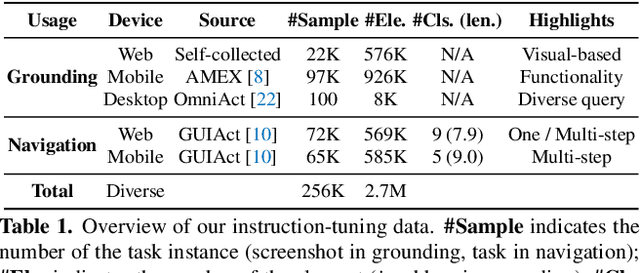
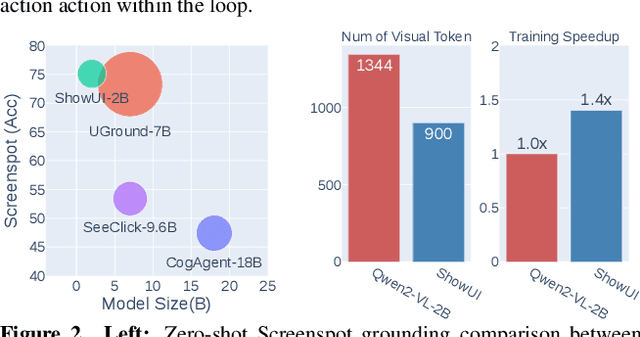
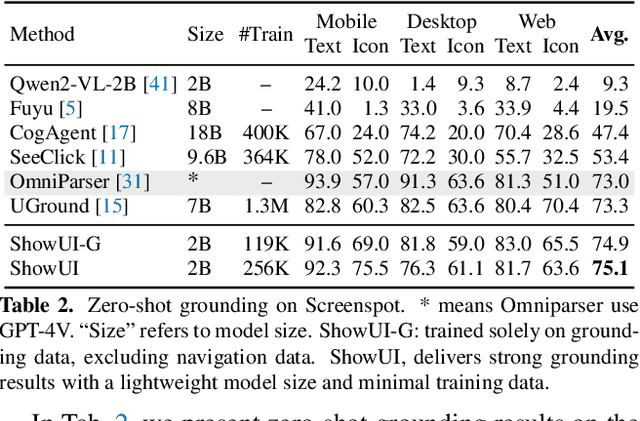
Abstract:Building Graphical User Interface (GUI) assistants holds significant promise for enhancing human workflow productivity. While most agents are language-based, relying on closed-source API with text-rich meta-information (e.g., HTML or accessibility tree), they show limitations in perceiving UI visuals as humans do, highlighting the need for GUI visual agents. In this work, we develop a vision-language-action model in digital world, namely ShowUI, which features the following innovations: (i) UI-Guided Visual Token Selection to reduce computational costs by formulating screenshots as an UI connected graph, adaptively identifying their redundant relationship and serve as the criteria for token selection during self-attention blocks; (ii) Interleaved Vision-Language-Action Streaming that flexibly unifies diverse needs within GUI tasks, enabling effective management of visual-action history in navigation or pairing multi-turn query-action sequences per screenshot to enhance training efficiency; (iii) Small-scale High-quality GUI Instruction-following Datasets by careful data curation and employing a resampling strategy to address significant data type imbalances. With above components, ShowUI, a lightweight 2B model using 256K data, achieves a strong 75.1% accuracy in zero-shot screenshot grounding. Its UI-guided token selection further reduces 33% of redundant visual tokens during training and speeds up the performance by 1.4x. Navigation experiments across web Mind2Web, mobile AITW, and online MiniWob environments further underscore the effectiveness and potential of our model in advancing GUI visual agents. The models are available at https://github.com/showlab/ShowUI.
Factorized Visual Tokenization and Generation
Nov 25, 2024Abstract:Visual tokenizers are fundamental to image generation. They convert visual data into discrete tokens, enabling transformer-based models to excel at image generation. Despite their success, VQ-based tokenizers like VQGAN face significant limitations due to constrained vocabulary sizes. Simply expanding the codebook often leads to training instability and diminishing performance gains, making scalability a critical challenge. In this work, we introduce Factorized Quantization (FQ), a novel approach that revitalizes VQ-based tokenizers by decomposing a large codebook into multiple independent sub-codebooks. This factorization reduces the lookup complexity of large codebooks, enabling more efficient and scalable visual tokenization. To ensure each sub-codebook captures distinct and complementary information, we propose a disentanglement regularization that explicitly reduces redundancy, promoting diversity across the sub-codebooks. Furthermore, we integrate representation learning into the training process, leveraging pretrained vision models like CLIP and DINO to infuse semantic richness into the learned representations. This design ensures our tokenizer captures diverse semantic levels, leading to more expressive and disentangled representations. Experiments show that the proposed FQGAN model substantially improves the reconstruction quality of visual tokenizers, achieving state-of-the-art performance. We further demonstrate that this tokenizer can be effectively adapted into auto-regressive image generation. https://showlab.github.io/FQGAN
One Token to Seg Them All: Language Instructed Reasoning Segmentation in Videos
Sep 29, 2024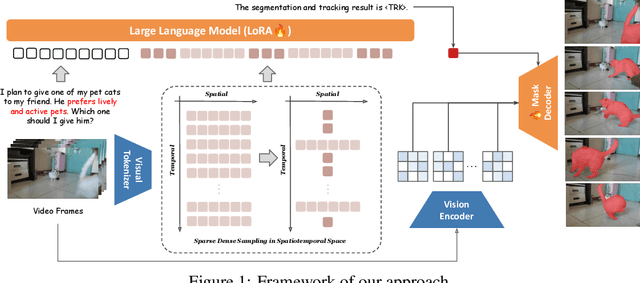
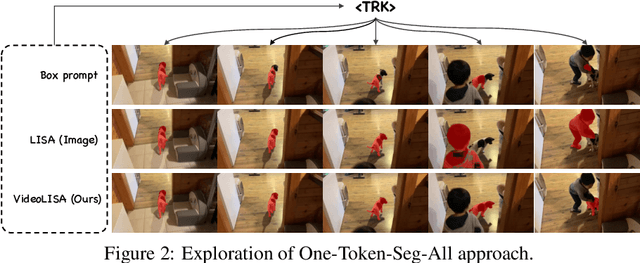

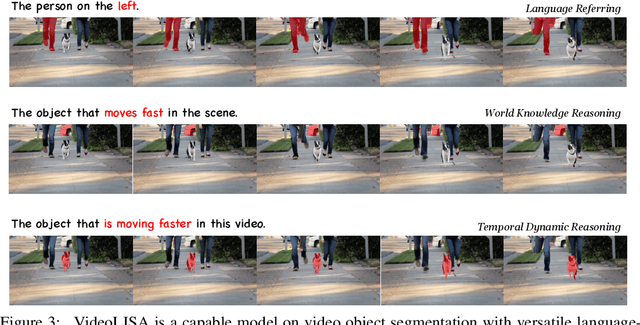
Abstract:We introduce VideoLISA, a video-based multimodal large language model designed to tackle the problem of language-instructed reasoning segmentation in videos. Leveraging the reasoning capabilities and world knowledge of large language models, and augmented by the Segment Anything Model, VideoLISA generates temporally consistent segmentation masks in videos based on language instructions. Existing image-based methods, such as LISA, struggle with video tasks due to the additional temporal dimension, which requires temporal dynamic understanding and consistent segmentation across frames. VideoLISA addresses these challenges by integrating a Sparse Dense Sampling strategy into the video-LLM, which balances temporal context and spatial detail within computational constraints. Additionally, we propose a One-Token-Seg-All approach using a specially designed <TRK> token, enabling the model to segment and track objects across multiple frames. Extensive evaluations on diverse benchmarks, including our newly introduced ReasonVOS benchmark, demonstrate VideoLISA's superior performance in video object segmentation tasks involving complex reasoning, temporal understanding, and object tracking. While optimized for videos, VideoLISA also shows promising generalization to image segmentation, revealing its potential as a unified foundation model for language-instructed object segmentation. Code and model will be available at: https://github.com/showlab/VideoLISA.
Show-o: One Single Transformer to Unify Multimodal Understanding and Generation
Aug 22, 2024



Abstract:We present a unified transformer, i.e., Show-o, that unifies multimodal understanding and generation. Unlike fully autoregressive models, Show-o unifies autoregressive and (discrete) diffusion modeling to adaptively handle inputs and outputs of various and mixed modalities. The unified model flexibly supports a wide range of vision-language tasks including visual question-answering, text-to-image generation, text-guided inpainting/extrapolation, and mixed-modality generation. Across various benchmarks, it demonstrates comparable or superior performance to existing individual models with an equivalent or larger number of parameters tailored for understanding or generation. This significantly highlights its potential as a next-generation foundation model. Code and models are released at https://github.com/showlab/Show-o.
GQE: Generalized Query Expansion for Enhanced Text-Video Retrieval
Aug 14, 2024Abstract:In the rapidly expanding domain of web video content, the task of text-video retrieval has become increasingly critical, bridging the semantic gap between textual queries and video data. This paper introduces a novel data-centric approach, Generalized Query Expansion (GQE), to address the inherent information imbalance between text and video, enhancing the effectiveness of text-video retrieval systems. Unlike traditional model-centric methods that focus on designing intricate cross-modal interaction mechanisms, GQE aims to expand the text queries associated with videos both during training and testing phases. By adaptively segmenting videos into short clips and employing zero-shot captioning, GQE enriches the training dataset with comprehensive scene descriptions, effectively bridging the data imbalance gap. Furthermore, during retrieval, GQE utilizes Large Language Models (LLM) to generate a diverse set of queries and a query selection module to filter these queries based on relevance and diversity, thus optimizing retrieval performance while reducing computational overhead. Our contributions include a detailed examination of the information imbalance challenge, a novel approach to query expansion in video-text datasets, and the introduction of a query selection strategy that enhances retrieval accuracy without increasing computational costs. GQE achieves state-of-the-art performance on several benchmarks, including MSR-VTT, MSVD, LSMDC, and VATEX, demonstrating the effectiveness of addressing text-video retrieval from a data-centric perspective.
Adaptive Slot Attention: Object Discovery with Dynamic Slot Number
Jun 13, 2024
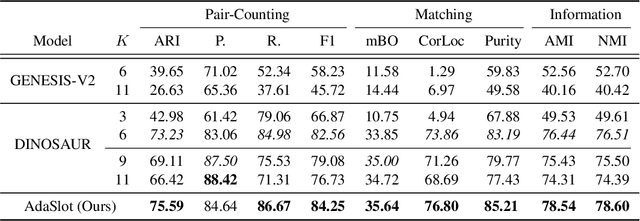
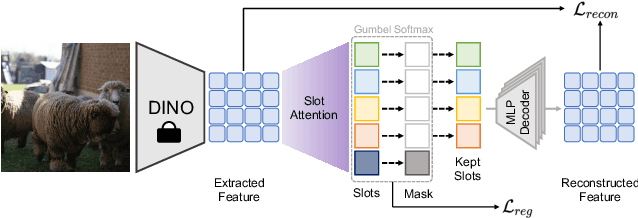

Abstract:Object-centric learning (OCL) extracts the representation of objects with slots, offering an exceptional blend of flexibility and interpretability for abstracting low-level perceptual features. A widely adopted method within OCL is slot attention, which utilizes attention mechanisms to iteratively refine slot representations. However, a major drawback of most object-centric models, including slot attention, is their reliance on predefining the number of slots. This not only necessitates prior knowledge of the dataset but also overlooks the inherent variability in the number of objects present in each instance. To overcome this fundamental limitation, we present a novel complexity-aware object auto-encoder framework. Within this framework, we introduce an adaptive slot attention (AdaSlot) mechanism that dynamically determines the optimal number of slots based on the content of the data. This is achieved by proposing a discrete slot sampling module that is responsible for selecting an appropriate number of slots from a candidate list. Furthermore, we introduce a masked slot decoder that suppresses unselected slots during the decoding process. Our framework, tested extensively on object discovery tasks with various datasets, shows performance matching or exceeding top fixed-slot models. Moreover, our analysis substantiates that our method exhibits the capability to dynamically adapt the slot number according to each instance's complexity, offering the potential for further exploration in slot attention research. Project will be available at https://kfan21.github.io/AdaSlot/
Hallucination of Multimodal Large Language Models: A Survey
Apr 29, 2024



Abstract:This survey presents a comprehensive analysis of the phenomenon of hallucination in multimodal large language models (MLLMs), also known as Large Vision-Language Models (LVLMs), which have demonstrated significant advancements and remarkable abilities in multimodal tasks. Despite these promising developments, MLLMs often generate outputs that are inconsistent with the visual content, a challenge known as hallucination, which poses substantial obstacles to their practical deployment and raises concerns regarding their reliability in real-world applications. This problem has attracted increasing attention, prompting efforts to detect and mitigate such inaccuracies. We review recent advances in identifying, evaluating, and mitigating these hallucinations, offering a detailed overview of the underlying causes, evaluation benchmarks, metrics, and strategies developed to address this issue. Additionally, we analyze the current challenges and limitations, formulating open questions that delineate potential pathways for future research. By drawing the granular classification and landscapes of hallucination causes, evaluation benchmarks, and mitigation methods, this survey aims to deepen the understanding of hallucinations in MLLMs and inspire further advancements in the field. Through our thorough and in-depth review, we contribute to the ongoing dialogue on enhancing the robustness and reliability of MLLMs, providing valuable insights and resources for researchers and practitioners alike. Resources are available at: https://github.com/showlab/Awesome-MLLM-Hallucination.
Bring Your Own Character: A Holistic Solution for Automatic Facial Animation Generation of Customized Characters
Feb 21, 2024Abstract:Animating virtual characters has always been a fundamental research problem in virtual reality (VR). Facial animations play a crucial role as they effectively convey emotions and attitudes of virtual humans. However, creating such facial animations can be challenging, as current methods often involve utilization of expensive motion capture devices or significant investments of time and effort from human animators in tuning animation parameters. In this paper, we propose a holistic solution to automatically animate virtual human faces. In our solution, a deep learning model was first trained to retarget the facial expression from input face images to virtual human faces by estimating the blendshape coefficients. This method offers the flexibility of generating animations with characters of different appearances and blendshape topologies. Second, a practical toolkit was developed using Unity 3D, making it compatible with the most popular VR applications. The toolkit accepts both image and video as input to animate the target virtual human faces and enables users to manipulate the animation results. Furthermore, inspired by the spirit of Human-in-the-loop (HITL), we leveraged user feedback to further improve the performance of the model and toolkit, thereby increasing the customization properties to suit user preferences. The whole solution, for which we will make the code public, has the potential to accelerate the generation of facial animations for use in VR applications.
Skip : A Simple Method to Reduce Hallucination in Large Vision-Language Models
Feb 12, 2024Abstract:Recent advancements in large vision-language models (LVLMs) have demonstrated impressive capability in visual information understanding with human language. Despite these advances, LVLMs still face challenges with multimodal hallucination, such as generating text descriptions of objects that are not present in the visual information. However, the underlying fundamental reasons of multimodal hallucinations remain poorly explored. In this paper, we propose a new perspective, suggesting that the inherent biases in LVLMs might be a key factor in hallucinations. Specifically, we systematically identify a semantic shift bias related to paragraph breaks (\n\n), where the content before and after '\n\n' in the training data frequently exhibit significant semantic changes. This pattern leads the model to infer that the contents following '\n\n' should be obviously different from the preceding contents with less hallucinatory descriptions, thereby increasing the probability of hallucinatory descriptions subsequent to the '\n\n'. We have validated this hypothesis on multiple publicly available LVLMs. Besides, we find that deliberately inserting '\n\n' at the generated description can induce more hallucinations. A simple method is proposed to effectively mitigate the hallucination of LVLMs by skipping the output of '\n'.
 Add to Chrome
Add to Chrome Add to Firefox
Add to Firefox Add to Edge
Add to Edge